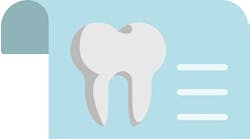By Joe Blaes
The pages of this month's issue are filled with new information. It is hard to believe that we are almost halfway through the year already. Hope things are going well for you both in your life and in your practice.
Be sure to read a great cover story by Dr. Dan Sindelar, the cofounder of the American Academy for Oral Systemic Health. This article will bring you up-to-date on what is happening around the country and the world with the connection of oral health to systemic health. You need to be helping your patients by educating them about the systemic problems that may have causal relationships to oral diseases. Included is a step-by-step program outlining how to get a physician involved in this process.
There are three columns that give really important information on the numbers you need to watch in your practice to be successful. I cannot believe that three of my regular authors came up with numbers to watch in the same month. This is a great time of the year to institute a system of watching these numbers on a regular basis – the more regular, the better. The three articles are: "Practice Success" by Dr. Roger Levin, "Secrets to Success" by Dr. Michael Kesner, and "Inside THE PRACTICE" by Jay Geier.
Dr. Neal Patel has written a fascinating article loaded with great information on the MiniStar and how to develop a "hands-on" team. This month's "Implementing Technology" column will give you information you can quickly implement into your practice. His goal is to give you the help you need to bring procedures to your practice that you may not be using at the present time to increase your productivity.
In the "3D Dentistry" column, Dr. Ed Shellard interviews Dr. Mark Setter on "Three-Dimensional Imaging Should NOT be Limited to Implantology." Dr. Setter describes many other situations where a CBCT scan will give you more information to aid in your diagnosis and treatment planning. He finds that utilizing 3-D scans is helpful in patient communication and case acceptance. 3-D scans are also useful in determining bone morphology in periodontally diseased patients and in certain endodontic evaluations. Don't miss this one.
I am writing this column in early May. I have just returned from speaking all day Friday in Cleveland, Ohio. My audience was a great group of dentists who were very attentive and asked a lot of great questions. They don't know this, but I think I learned as much from them as they learned from me. I was beginning a section on Adhesive Dentistry and began talking about 7th and 8th generation bonding agents. I was getting some blank stares from the audience so I asked how many of them were using these self-etch adhesives. Only one or two hands went up, so I asked them to give me the names of the adhesives they were using on a regular basis. Most of them were using 4th and 5th generation bonding agents. I asked why and the answer was unanimous, "because they work and we don't have any postop sensitivity."
I think that was a great answer, but my concern is that those products are much more technique sensitive than the later generation bonding agents. But these dentists had obviously learned how to use these adhesives correctly and are getting excellent results.
I love to take some books on vacation with me to catch up on my reading. Here are two books on my list this summer. First, I'm reading The 21 Irrefutable Laws of Leadership by John C. Maxwell. Follow these laws and people will follow you. John is one of the great communicators of our time and this book is made for dental practices. Before you spend a lot of time on a leadership course, read this book!
Second, I am in the process of rereading The 7 Habits of Highly Effective People by Stephen Covey. This book came out over 20 years ago but it is still a great read and a terrific leadership handbook. My copy has lots of highlighted sections and notes in the margins from the first and second times I read this book. It also seems to be written for dental practices.
Have a great summer and take some time to reconnect with family and recharge your batteries!
Joe Blaes, DDS, Editor
email: [email protected]
Past DE Articles





